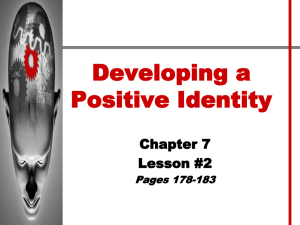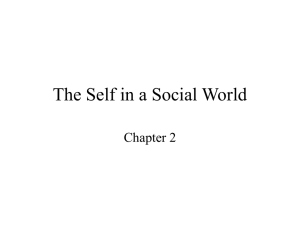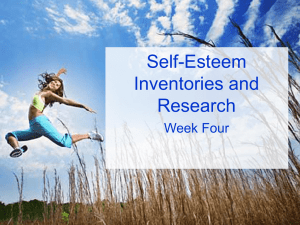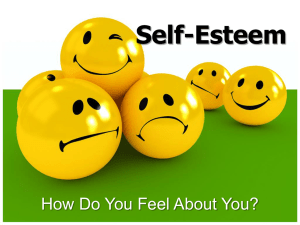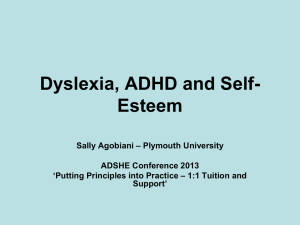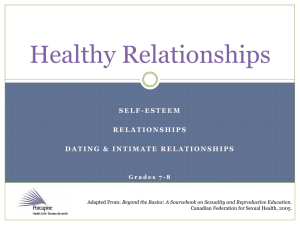Motivation Through Self-Esteem in the Classroom
advertisement
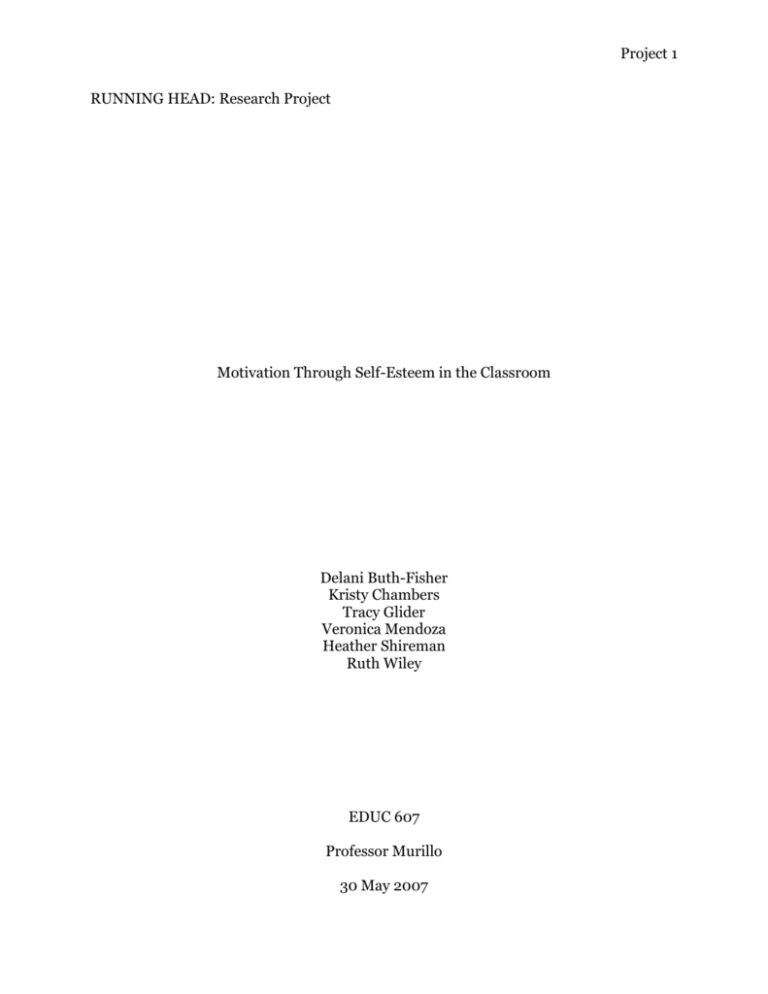
Project 1 RUNNING HEAD: Research Project Motivation Through Self-Esteem in the Classroom Delani Buth-Fisher Kristy Chambers Tracy Glider Veronica Mendoza Heather Shireman Ruth Wiley EDUC 607 Professor Murillo 30 May 2007 Project 2 1. Title 2. Abstract 3. Introduction a. General Statement of the Problem b. Literature Review c. Assumptions d. Foreshadowed Problems e. Definition of terms f. Significance of Proposed Study 4. Design and Methodology a. Subjects b. Instrumentation/Data Collection c. Data Treatment Procedures d. Presentation Findings e. Limitations of the Design 5. Conclusion 6. Recommendations for Further Research 7. Appendices a. Appendix I: Educational Terms b. Appendix II: Survey c. Appendix III: Type of Classroom d. Appendix IV: Teacher Demographics 8. References Project 3 ABSTRACT The purpose of our study was to investigate the different strategies used by special education teachers to develop self-esteem in their students. We also wanted to find out if these strategies used by the classroom teachers are the same as what professionals with in the field of special education have declared as “good self-esteem strategies.” We believe that there is a string correlation between self-esteem and academic success. The study was derived using qualitative research with a survey consisting of questions and Likert scales. We also asked participants to describe their philosophies of education. Results were compiled using charting and compiling of data. The participants were compiled of 25, Kindergarten -9th grade special education teachers (RSP and SDC) who have taught between 1 and 36 years in the classroom. The teachers were from Val Verde and Moreno Valley Unified School Districts. The results of our research indicated that the teachers in our research group use a variety of techniques to develop self-esteem in their students to which many of the same techniques were correlated to existing research INTRODUCTION The purpose of this study was to assess whether or not self-esteem building has a direct relationship between the ease of mainstreaming and academic success. If so, what strategies are used to increase self-esteem. A questionnaire with 12 questions was given to 36 special education classroom teachers, with 25 returned surveys. Then the information was gathered to determine if there is a direct relationship between increasing self-esteem and improving academic success. Students in special education are being included in the general education classrooms in accordance to the laws in many educational settings. It’s important for Project 4 children to be able to work to their greatest potential, but also at a level that they can be successful. Research has been conducted on the academic benefits for both disabled and their non-disabled peers participating in inclusionary programming. However, reading, writing, social studies, science, math and related arts are not the only subjects schools need to be concerned with when it comes to education. Educators need to focus on their students’ self-esteem and social well being. The education of students with special needs, including learning disabled children, has been an ever-changing process since the inception of identifying these students. Practices of separating students with learning disabilities in an educational setting different from their age appropriate peers, is an educational strategy from the past. Boundaries that once separated LD students from their peers has become increasingly more invisible, since inclusion/mainstreaming policies were implemented. The passing of Public Law 94-142, the Education for All Handicapped Children Act (1975) and the renewed mandate of this law known as Individuals with Disabilities Act (IDEA) has assured that students with learning disabilities will be educated in the least restricted environment when appropriate. This brought a revolutionary change in special education. Learning disabled students were no longer being educated in a selfcontained classroom separate from their age appropriate peers, but instead along side them in general education classrooms. “Children with aspergers, as well as other disabilities, that manifest social skills problems can negatively impact every aspect of their life including self-esteem” (Myles, 1999, p. 280). One social skill area, the hidden curriculum, is quite troublesome for such students. These skills are not taught per se, but are assumed that all children encompass. Researchers and practitioners have discussed the negative impacts of not Project 5 having the appropriate social skills. Lacking such skills can manifest themselves in not being able to develop friendships, to being ridiculed by peers, or having difficulty keeping a job due to the lack of understanding of workplace and culture. The hidden curriculum covers a multitude of areas and topics that the special education teacher should use self-esteem techniques to address on a daily basis. The curriculum varies across locations, situations, ages, people, and cultures. Instruction includes providing direct assistance in skill provision, such as using a scope and sequence chart to identify skill areas in which the other child may be deficient and providing direct instruction to teach those skills. Instructional components include various strategies. One of the most important strategies stated in the article is building the child’s self-esteem. The child with a disability may look, feel, and act different than the “regular” education students. The child is often aware of such differences and loss of self-esteem is the by-product. Teachers and parents need to focus on the students strengths and stress them on a consistent basis. Presenting several opportunities for a child to demonstrate his or her strengths will definitely build self-esteem. Additional strategies might include placing the child in the role of tutor or helper, reframe negative language to positive language, find out what the child does well and help them do more of it, compliment the child, and teach them to compliment themselves. All of the strategies utilized in the study, and were proven to help build children’s self-esteem and make their life easier in every other aspect of their life. In this article the purpose of this study was to evaluate how effective social skills training were regarding self-esteem, peer acceptance, social attraction, and selfconfidence of children with physical or cognitive disabilities. This research, in turn Project 6 raises some questions, such as, is mainstreaming more harmful or hurtful to the child’s self-esteem with disabilities? Does their social acceptance weigh heavily on the level of their specific disability (mild verses severe disability)? Finally, will social training truly help the inclusive classroom or will kids, generally just be kids and exclude the unfamiliar? There were 49 fourth grade children involved in this study were made up of two different groups, the controlled and treatment group. The school counselor assessed all the students at the start of the year to discover their social weaknesses. The school counselor came in once a week to teach the social skills curriculum, as well as use individual and group counseling to assist any student’s additional needs. Every student was given the chance to use role playing and completed “people-skill” notebooks that had the necessary steps to perform each social skill. The school counselor used the Skill Streaming the Elementary School Child curriculum to train the students on the topic of pragmatics. The skills were introduced, taught, and practiced through modeling, roleplaying, performance feedback, and written assignments. The results of this study indicate that the gifted students and students with disabilities that were given social skills training improved on the Social Attraction factor of BASE, thus realizing that social attraction is linked with higher self-esteem. It was also noted that special education students that interact with their peers that are nondisabled are more accepted than peers that have little or no interaction. The teachers exclaimed that the children in the treatment group increased their level of social success and were much more interactive with all their peers. In addition, students’ attitudes towards others increased over the span of one year. The authors concluded the research by mentioning that although special education students can be taught social skills in Project 7 their own classroom, it does nothing if they cannot practice it in a regular education setting. Interacting with their non-disabled peers in a social context gives those social skills, tools, and opportunities for future success. This article clearly indicates that by using the proper strategies for building self-esteem the children are more successful in “regular” education settings. Strategy fading and progress feedback: Effects on self-efficacy and comprehension. The article by Schunk & Rice, (Schunk, 1993, p. 271) claimed that “students with learning disabilities often do not work on tasks strategically and hold low perceptions of learning capabilities.” This brings up the use of teaching strategies in the classroom environment. The study explains the importance of students’ understanding of what strategies are and how to use them effectively. The main emphasis of the article deals with testing strategies to find which works best in the classroom setting. The findings proved that self-verbalization and teacher feedback when used in unison were the most effective strategies. Schunk and Rice (Schunk, 1993, p. 270) stated that they recommend the use of the “strategy fading and strategy feedback.” These procedures are a way to foster students’ self-regulated strategy use, self-efficacy, and skill development. This may be a way for students to become more confident and involved in their own learning. Teaching strategies for twice-exceptional students. The article describes teaching and learning methods that teachers and parents can use to facilitate progress in learning for twice-exceptional students with both strengths and weaknesses. The following are strategies addressed in the study; “teach students the appreciation of individual differences, teach content concepts first and details second, teach to tie past learning to new concepts, provide specific instructional organization techniques” Project 8 (Winebrenner, 2003, pp. 133-135) The author wrote, “Although most teachers believe that all students should have their self-esteem needs met as part of their learning experience, few realize that self-esteem actually is enhanced when success is attained through tasks an individual considers challenging” (Winebrenner, 2003, p.136). We as teachers and researchers must find what works for each individual student to learn most effectively, however, the article suggests that this is obviously not an easy task. Effective teaching strategies for gifted/learning-disabled students with spatial strengths. The focus of this study was to find effective teaching strategies for students with weaknesses with typically simple material, but that have high-level ability with spatial tasks. A teacher interviewed for the study said, “Don’t get caught up in techniques; get caught up in the student” (Mann, 2006, p. 116). Meaning that teachers should get to know their students well enough before they begin teaching those using strategies and techniques that may not work. Not all students have the same learning style, but individual styles. According to Mann, the high school used in the study uses “curriculum that focuses on creative and critical thinking skill enhancement and teaching problem solving strategies” to students (Mann, 2006, p. 119). The findings from the article are clear that the curriculum works. Over ninety percent of graduating students pursued postsecondary education, which is a huge achievement for those students that previously were not accepted in a regular public school environment. Through this research, there are two main assumptions. First, mainstreaming is an acceptable placement option for special education students in order to maximize their access to the core curriculum. Second, all students are capable of learning. Various problems have been encountered in the field of education regarding mainstreaming. Mainstreaming is a big change in placement that puts the special Project 9 education student in an entirely new and unfamiliar environment. The skills necessary to maintain a successful transition may, or may not, have been taught. Which would result in ostracism and/or shame. It has been evidenced by teacher complaint, that many special education students are seen as bothersome to the general education students when mainstreamed. While these problems do exist, certain strategies promote academic-success for the general education class and mainstreamed student. An increased level of self-esteem has a high correlation with academic success, and students with disabilities have been known to have lower self-esteem due to their disabilities. During the research process several issues arose. Primarily, several teachers did not return their completed surveys, in some instances follow-up phone calls were necessary to receive completed surveys. Access to data was only privy to those in the research group. There was no treatment component due to the qualitative nature of this research project. Jargon and terms used throughout the project were specific to the educational field and can be found in Appendix I. Professionals within the field of special education agree that building self-esteem in students is an effective and meaningful way to help students adapt to any future expectations they may encounter when they are mainstreamed into a regular classroom. Our proposed study is significant to this issue because we will be looking at the techniques used by classroom teachers and then comparing them to what other researchers have deemed to be good quality practices. Future research into this issue may include how a classroom’s demographics help to determine instructional techniques used by the teacher. Project 10 Self-Esteem and Motivation are important aspects of this research project. In accordance with reviewed literature and texts, self-esteem and motivation have been thusly described: Self-Esteem: the self-evaluative part of the self-concept, the judgment children make about their overall worth. Motivation: something that motivates; inducement; incentive. Two types of motivation are extrinsic and intrinsic, which occur from outward or inward loci of incentive. Research has shown that students who are intrinsically motivated fare better in the classroom (Brooks, 1998, p. 3); motivation stays with the student rather than in the environment. Less motivated or disengaged students, on the other hand, "are passive, do not try hard, and give up easily in the face of challenges" (Skinner, 1991, p. 4). Use extrinsic rewards sparingly. If extrinsic motivators are to be used, they are most effective when rewards are closely related to the task accomplished. Also, rewards should only be given when they are clearly deserved. Giving a prize for minimally successful work sends the message that minimum effort is acceptable, and the reward then becomes meaningless (Brooks, 1998, p. 6) "When a student completes an assignment that does not meet the expected criteria, give her or him one or more opportunities to tackle the task again, with guidelines on how to achieve the desired result" (Dev, 1997, p. 17). DESIGN AND METHODOLOGY The subjects of this study were 30 teachers from Moreno Valley Unified School District and Val Verde School District. Out of the 30 surveys disbursed to the selected teachers, only 25 participants responded. Out of these respondents, there were 21 females and 4 males; 16 Caucasians, 2 African-Americans, 2 Hispanics, and 5 other Project 11 ethnic decent. The type of classroom the participants were K-8, Language-Arts, Mathematics, English Language Development, Resource Specialist, History and Science. The number of years teaching ranges from 1 to 20+; the largest group (mode) has 20+ years with six teachers. Charts and percentages can be found in Appendix III and IV. Our research group wanted to conduct a qualitative research project that would assess academic success and self-esteem in the classroom. We developed a survey that was designed to find significant facts about teachers and their classrooms to determine the level of self-esteem and various motivational strategies that the participants utilize in their classrooms. After the survey was developed, two researchers from our group distributed them. Surveys were emailed/handed out by Tracy Glider and Ruth Wiley. Permission to use the participants’ responses was gathered through a consent form, which was attached to each survey. Said consent form stated that by responding electronically or handing in the completed survey, the participants consented to the research group using the information. Surveys were either printed from a secure email server or handed in to one group member who kept them in a secured folder to ensure confidentiality of the respondents. The criterion used to determine the survey was the degree of ease in answering the questions. Those in the education field who created the survey finalized these questions, authenticating the importance of each question through relevance of results to the research goal. The pilot study done brought attention to the questions that caused confusion or seemed to negate the purpose of the study. The instrument used was an electronic, and hard copy, survey. Surveys were emailed throughout Moreno Valley Unified School District and Val Verde Unified School District. Project 12 The objectives of this study were selected to compare what motivational strategies were being used in the classroom with the strategies supported by literature review. The teachers who were selected for the pilot study were chose based on their availability. These participants were easily accessible to the researchers for questions and/or suggestions for improvement on the survey questions. Selection of participants was based on the limited access to teachers. Only two researchers had access to classrooms and schools. Various adjustments were done in the process of charting and compiling of data. One particular question could not reveal any information that was pertinent to the research project. Due to the isolated nature of the question, researchers chose to disregard its results, eliminating its impact on the project. Throughout this project the researchers found several advantages and disadvantages. Advantages found in the research project were the summation of current practices from sampled population, the collective attitude of a general philosophy of education, and age range information of the participants. We developed ten categories based on the questions on the survey and then we assigned each teacher’s response to the corresponding category. As a group, we determined which data was relevant and eliminated categories that were not pertinent to our research. As a group, we looked at the actual strategies used by our survey group and the strategies listed by the literature and correlated the two. We then drew our conclusions according to the information from the surveys and the literature. This survey found that the following motivational strategies are being utilized in the classroom, which correlate with the literature review. Table 1: Correlated Teaching Strategies from the Research and the Survey Project 13 Data 1. Use humor 2. Learn and share skills using the computer 3. Computer time when work is done 4. Connect with students daily; try to get to know them as an individual 5. Know your learners 6. Make time to talk alone with students 7. “You must give respect before you can expect it” 8. Respect and never patronize 9. Respect children and parents 10. Encourage respect toward others 11. Positive feedback 12. Encourage learners 13. Giving students tasks that they can be succeed at 14. Modify work to student level so they are successful at their work 15. Increase student’s confidence by starting the day with a few questions or activities the students can easily accomplish 16. On tests, intersperse easier questions with difficult ones to keep motivation levels high 17. Create and maintain a comfortable learning environment 18. Refusal to allow students to say “I can’t” 19. Create a positive class environment 20. Connect lessons to student’s background knowledge 21. Teach in a way that ties past learning to new content 22. Take time for sharing especially when we have been on a long break 23. Emphasize teamwork 24. Cooperative learning 25. Peer-tutoring 26. Finding student strengths and incorporate that into their assignments 27. Build on student strengths 28. Help students write a “Things I like about me” list. Make it a regular part of interaction 29. Incorporate students interests into the assignments 30. Giving students choices or assign projects 31. teach discovery learning 32. Walking around the classroom during independent practice and making positive comments as they work. 33. structure learning to be flexible and supportive 34. Breakdown tasks into small steps and praise students for success in each step 35. Everyone gets a chance to read 36. Help students acknowledge success 37. Structure the learning environment and social situations to promote success 38. “We can all learn from one another” 39. Listen to what they have to say about almost anything they want to share (when there is time) 40. Encourage socialization Project 14 41. Social skills training for students 42. Encourage peer praise 43. Clapping for each other 44. Compliment students and encourage them to compliment others 45. Parent communication regarding success 46. Call parents to tell them when their child is doing well and not just when there is a problem Table 2a Teaching Strategies from Survey Data 1. Humor 2. Computer time if work is done Table 2b Teaching Strategies from the Research 1. Use Humor 2. Learn and share skills using the computer 3. Connect with each student daily; try 3. Know your learners to get to know them as an individual 4. Make time to talk alone with students 4. Praise: “make good choices”, “you 5. Respect and never patronize make a difference”, “you must give 6. Respect children and parents respect before you can expect it”, “tomorrow’s a new day”, thumb’s up, high fives, tell students to do their very best because they can do no better than their best, (6)positive feedback, “(19) we can all learn from one another”, “yes you can, you just need some help right now”, standing ovation, certificates of completion 5. Encourage respect towards each other’s cultural, learning, ethnic, and personal differences 6. Positive Feedback 7. Encourage learners 7. Giving students tasks that they can 8. Increase student’s confidence by succeed at starting the day with a few questions 8. Modify work to student level so they or activities the students can easily are successful in their work accomplish 9. On tests, intersperse easier questions with difficult ones to keep motivation levels high 9. Create and maintain a comfortable 10. Create a positive class environment learning environment 10. Refusal to allow students to say “I can’t” 11. Connect lessons to student’s 11. Teach in a way that ties past Project 15 background knowledge 12. Take time for sharing especially when we have been on a long break 13. Emphasize teamwork 14. Finding student strengths and incorporate that into their assignments 15. Giving students choices or assign projects 16. Walking around the classroom during independent practice and making positive comments as they work 17. Break down tasks into small steps and praise students for success in each step 18. Everyone gets a chance to read 19. “We can all learn from one another” 20. Listen to what they have to say about almost anything they want to share (when there is time) 21. Encourage peer praise 22. Clapping for each other 23. Parent communication regarding success 24. Posting affirmations within the classroom 25. Posting the student’s photo with a piece of quality work behind it for display 26. Birthday chart 27. Make learning meaningful to students 28. Write a letter of the student’s name on the “OOPS” board when the student is not paying attention 29. Give extra points and praise to students who are paying attention and doing what they should be doing 30. Give students a treat for returning homework learning to new content 12. Cooperative learning 13. Peer-tutoring 14. Build on students strengths 15. Help students write a “Things I like about me” list. Make this a regular part of interaction 16. Incorporate students interests into the assignments 17. Teach discovery learning 18. Structure learning to be flexible and supportive 19. Help students acknowledge success 20. Structure the learning environment and social situations to promote success 21. Encourage socialization 22. Social skills training for students 23. Compliment students and encourage them to compliment others 24. Call parents to tell them when their child is doing well and not just when there is a problem Project 16 31. Prizes: stickers, coupons, token system, earning cubes to fill the special treat jar, student store, parties 32. Extra time to answer questions 33. Consistent form of discipline; boundaries 34. Utilize academic materials that are used by my mainstream colleagues 35. Giving numerous examples before independent practice 36. Small arts and crafts activity 37. Individual contracts as needed 25. Congratulate students for returning to school 26. Conduct ice breaker activities 27. Recognize potential in all students 28. Employ interventions that increase self-verbalization 29. Place student as a helper or tutor for the class and/or teacher 30. Refrain negative language to positive language 31. Provide information about the brain and how students learn 32. Non-verbal communication is vital in fostering self-esteem in children 33. Show faith in the students ability to change 34. Speak softly in a non-threatening manner if the student shows nervousness. 35. Look for opportunities for students to display leadership roles in class 36. Seek to involve students in lesson presentation, it will increase the involvement of all of the students in the class 37. Involve the student as a responder and thinker, not simply a passive listener 38. Try to maintain a ration of four positive comments for every negative comment 39. Provide only fading to students 40. Provide fading plus feedback to Project 17 students 41. Teach advocacy skills 42. Students interests should be explored 43. Opportunities for authentic and experiential learning are necessary for students to find value in the tasks in which they are asked to perform 44. Take responsibility for actions 45. Recognize perfectionism and use to build self-esteem 46. Use meditation, management, modification, modeling, and mothering In table one, the evidence shows a direct correlation between the teaching strategies listed from the teacher surveys collected and the teaching strategies collected from research articles. Table one shows forty-six teaching strategies that overlapped from the survey data and the research. Table 2a shows a list thirty-seven teaching strategies from the collected survey data, whereas table 2b shows a list of forty-six teaching strategies from the research. As you observe the tables, you will notice that there is over fifty percent correlation between the research strategies and the strategies the teachers are using. The most prevalent correlated strategies were based on respect, student success, cooperative learning, building on student strengths, and socialization. After studying the tables, a few questions are brought to mind. How much do teachers support the research? Have the teachers found their own strategies to be more effective? Time constraints were a big factor in completing this project. The study would have been comprehensive if we would have had the time to include an interview or an observation along with our survey. This would have allowed for the research group to collect much more substantial data and to confirm that the techniques that teachers reported that they were using were in fact used during instruction time. Project 18 Time was also a factor in developing our survey. If there had been more time we would have been able to examine our survey question more closely. Upon compiling the data we realized that some our questions were very complex and subject to interpretation by the study group which resulted in additional data being collected. CONCLUSION While there is a strong correlation between engagement and achievement, many have not deemed this issue as a valid topic for discussion. As schools focus on helping all students achieve high standards, reaching out to disengaged and discouraged learners becomes increasingly important. Clearly, students who are not motivated to engage in learning are unlikely to succeed. So in light of the evidence used in the classrooms, motivational strategies Educators can, and do, affect students' level of engagement in learning and in the classroom. By simply recognizing this power, educators have taken a significant step in motivating students. By further recognizing how a healthy self-esteem is the foundation for success, which in turn fosters motivation and engagement in school, teachers can see the connections between their practice and student outcomes. RECOMMENDATIONS FOR FURTHER RESEARCH One area for further research could be looking to see if the students’ academic progress supports the techniques used by teachers. This would be a significant addition to the research because it would provide evidence that the techniques being used to raise self-esteem are having a positive impact on the students’ academic success. APPENDICES Project 19 Appendix I: Educational Terms ("Glossary of Educational Terms", 2007) Accommodations Changes in the way tests are designed or administered to respond to the special needs of students with disabilities and English learners (EL). Accountability The notion that people (e.g., students or teachers) or an organization (e.g., a school, school district, or state department of education) should be held responsible for improving student achievement and should be rewarded or sanctioned for their success or lack of success in doing so. Achievement test A test to measure a student's knowledge and skills. (Ed Source) Assessment Teacher-made tests, standardized tests, or tests from textbook companies that are used to evaluate student performance. At-risk student Students may be labeled at risk if they are not succeeding in school based on information gathered from test scores, attendance, or discipline problems. Benchmarks A detailed description of a specific level of student achievement expected of students at particular ages, grades, or developmental levels; academic goals set for each grade level. California Content Standards The official definitions from the state Board of Education of what children need to know and learn at a particular grade level. California Education Code (Ed Code) A collection of all the laws directly related to California K-12 public schools. Ed Code sections are created or changed by the governor and legislature when they make laws. Curriculum The courses of study offered by a school or district. California has developed a set of standards that are intended to guide curriculum and instruction. The final decisions about school curriculum are the responsibility of the local school board. Differentiated instruction This is also referred to as "individualized" or "customized" instruction. The curriculum offers several different learning experiences within one lesson to meet students' varied needs or learning styles. For example, different teaching methods for students with learning disabilities. Individual Education Program (IEP) A written plan created for a student with learning disabilities by the student's teachers, parents or guardians, the school administrator, and other interested parties. The plan is tailored to the student's specific needs and abilities, and outlines goals for the student to reach. The IEP should be reviewed at least once a year. Standards-referenced tests Also known as standards-based assessments. Project 20 Appendix II: Survey Survey This survey is meant to assess the classroom environment in regards to motivational strategies and self-esteem building. Please fill out the questions below in regards to your students categorized as mild/moderate disability. 1. How long have you been teaching? 2. What level and subject(s) do you teach? 3. What type of classroom do you work in (i.e. general, SDC…) and what is the disability range in your classroom? 4. What is your ethnicity and gender? 5. What is the demographic make up of your classroom? 6. What is the age range in your classroom? 7. How many students are mainstreamed in your classroom and for what percentage of the day? 8. What would you estimate the overall level of self-assurance/esteem in your classroom. (Not at all) 0 – 1 – 2 – 3 – 4 – 5 (Very high) 9. How would you rate your attitude towards mainstreaming? (Not at all) 0 – 1 – 2 – 3 – 4 – 5 (Very high) 10. Do you feel that there is a strong correlation between self-esteem and academic success? (Not at all) 0 – 1 – 2 – 3 – 4 – 5 (Very high) 11. Write 2-4 sentences on your philosophy of education? 12. Please write 3-5 motivational/self-esteem boosting strategies you use in your classroom? (Please leave blank if you do not use these types of strategies) Project 21 Appendix III: Type of Classroom Type of Classroom SLI 19% SLI SLD 40% OHI AUTISTIC MR ED OHI 13% GEN ELD AH SLD AH 2%ELD GEN 2% 4% AUTISTIC 10% ED 6% MR 4% Appendix IV: Teacher Demographics Teacher Demographics Other 20% Caucasian Hispanic 8% African-American Hispanic Other African-American 8% Caucasian 64% Project 22 REFERENCES Brooks, S. R., Freiburger, S.M., & Grotheer, D.R. . (1998). Improving elementary student engagement in the learning process through integrated thematic instruction. Retrieved May 20, 2007 Dev, P. C. (1997). Intrinsic motivation and academic achievement: What does their relationship imply for the classroom teacher? Remedial and Special Education, 18(1), 12-19. Glossary of Educational Terms. (2007). School Wise Press. Retrieved May 7, 2007, from http://www.schoolwisepress.com/smart/dict/dict.html Mann, R. L. (2006). Effective teaching strategies for gifted/learning disabled students with spatial strengths. . The Journal of Secondary Gifted Education, 17(2), 112121. Myles, B. S. S., R.L. . (1999). Understanding the hidden curriculum: an essential social skill in children and youth with aspergers syndrome. Intervention in School & Clinic, 36(5), 279-287. Schunk, D. H., & Rice, Jo Mary. (1993). Strategy fading and progress feedback: effects on self-efficacy and comprehension among students receiving remedial reading services. The Journal of Special Education, 27(3), 257-276. Skinner, E., & Belmont, M. . (1991). A longitudinal study of motivation in school: Reciprocal effects of teacher their and student engagement. Unpublished manuscript, Rochester, NY. Winebrenner, S. (2003). Teaching strategies for twice-exceptional students. Intervention in School and Clinic, 38(3), 131-137.

